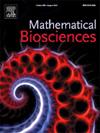A mechanistic modeling and estimation framework for environmental pathogen surveillance
IF 1.9
4区 数学
Q2 BIOLOGY
引用次数: 0
Abstract
Environmental pathogen surveillance is a promising disease surveillance modality that has been widely adopted for SARS-CoV-2 monitoring. The highly variable nature of environmental pathogen data is a challenge for integrating these data into public health response. One source of this variability is heterogeneous infection both within an individual over the course of infection as well as between individuals in their pathogen shedding over time. We present a mechanistic modeling and estimation framework for connecting environmental pathogen data to the number of infected individuals. Infected individuals are modeled as shedding pathogen into the environment via a Poisson process whose rate parameter varies over the course of their infection. These shedding curves are themselves random, allowing for variation between individuals. We show that this results in a Poisson process for environmental pathogen levels with rate parameter a function of the number of infected individuals, total shedding over the course of infection, and pathogen removal from the environment. Theoretical results include determination of identifiable parameters for the model from environmental pathogen data and simple, explicit formulas for the likelihood for particular choices of individual shedding curves. We give a two step Bayesian inference framework, where the first step corresponds to calibration from data where the number of infected individuals is known, followed by an estimation step from environmental surveillance data when the number of infected individuals is unknown. We apply this modeling and estimation framework to synthetic data, as well as to an empirical case study of SARS-CoV-2 in environmental dust collected from isolation rooms housing university students. Both the synthetic data and empirical case study indicate high inter-individual variation in shedding, leading to wide credible intervals for the number of infected individuals. We examine how uncertainty in estimates of the number of infected individuals from environmental pathogen levels scales with the true number of infected individuals and model misspecification. While credible intervals for the number of infected individuals are wide, our results suggest that distinguishing between no infection and small-to-moderate levels of infection ( infected individuals) may be possible, and that it is broadly possible to differentiate between moderate () and high () numbers of infected individuals.
环境病原体监测的机理建模和估算框架。
环境病原体监测是一种很有前景的疾病监测模式,已被广泛用于 SARS-CoV-2 监测。环境病原体数据的高度可变性是将这些数据纳入公共卫生应对措施的一个挑战。这种可变性的来源之一是个体内部在感染过程中的异质性感染,以及个体之间随着时间推移在病原体脱落方面的异质性感染。我们提出了一个将环境病原体数据与受感染个体数量联系起来的机理建模和估算框架。受感染个体被模拟为通过泊松过程将病原体脱落到环境中,泊松过程的速率参数 λt 随其感染过程而变化。这些脱落曲线 λt 本身是随机的,允许个体之间存在差异。我们的研究表明,这将导致环境病原体水平的泊松过程,其速率参数是受感染个体数量、感染过程中的总脱落量以及病原体从环境中清除量的函数。理论结果包括根据环境病原体数据确定模型的可识别参数,以及个体脱落曲线特定选择的简单明了的可能性公式。我们给出了一个两步贝叶斯推理框架,第一步是根据已知感染个体数量的数据进行校准,然后是根据未知感染个体数量的环境监测数据进行估计。我们将这一建模和估算框架应用于合成数据,以及从大学生隔离室收集的环境灰尘中 SARS-CoV-2 的实证案例研究。合成数据和经验案例研究都表明,脱落的个体间差异很大,导致感染人数的可信区间很宽。我们研究了从环境病原体水平估算出的受感染人数的不确定性如何与真实受感染人数和模型的错误规范成比例关系。虽然受感染个体数量的可信区间很宽,但我们的结果表明,区分无感染和中小规模感染(≈10 个受感染个体)是可能的,区分中等(≈40 个)和高(≈200 个)感染个体数量也是大体可行的。
本文章由计算机程序翻译,如有差异,请以英文原文为准。
求助全文
约1分钟内获得全文
求助全文
来源期刊

Mathematical Biosciences
生物-生物学
CiteScore
7.50
自引率
2.30%
发文量
67
审稿时长
18 days
期刊介绍:
Mathematical Biosciences publishes work providing new concepts or new understanding of biological systems using mathematical models, or methodological articles likely to find application to multiple biological systems. Papers are expected to present a major research finding of broad significance for the biological sciences, or mathematical biology. Mathematical Biosciences welcomes original research articles, letters, reviews and perspectives.
 求助内容:
求助内容: 应助结果提醒方式:
应助结果提醒方式:


